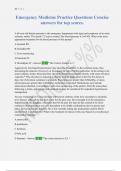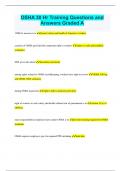1|Page
Emergency Medicine Practice Questions Concise
answers for top scores.
A 68-year-old female presents to the emergency department with signs and symptoms of an acute
ischemic stroke. The initial CT scan is normal. Her blood pressure is 164/105. What is the most
appropriate treatment for the blood pressure of this patient?
A Atenolol PO
B Clonidine PO
C Close monitoring
D Labetolol IV
E Nicardipine IV - Answer *The Correct Answer is: C
Aggressively lowering blood pressure may decrease blood flow to the ischemic tissue, thus
decreasing the chances of recovery or increasing the risk of further infarction. In the setting of an
acute ischemic stroke, blood pressure elevation should be monitored closely, with some elevation
expected.* This elevation is expected to decline without medication in the first few hours to
days, but if elevation continues to a systolic blood pressure greater than 220mmHg, or mean
arterial pressure greater than 120mmHg, medication is advised. Medications may include
intravenous labetolol or nicardipine, with close monitoring of the patient. After the acute phase
following a stroke, appropriate oral medications may be considered for outpatient hypertension
management.
You are evaluating a 67-year-old male with known cirrhosis of the liver secondary to alcoholic
liver disease, although he has been sober for the past year. He is brought in to the emergency
department by his daughter, who notes that for the past few days he has seemed to be more
confused. On examination you note the patient to be mildly confused but alert to person and
place. He has noticeable asterixis. He is not currently taking any medications and his blood
alcohol level is undetectable. What is the treatment of choice in this case based on your physical
examination findings?
A amoxicillin
B prednisone
C lactulose
D folic acid
E thiamine - Answer *The correct answer is (C). *
,2|Page
This patient most likely has hepatic encephalopathy due to end-stage liver disease. *Asterixis
indicates an increase in serum ammonia. The treatment of choice is lactulose. Both folic acid and
thiamine are used in the treatment of alcoholic liver disease, but do not treat elevated ammonia
levels.* Antibiotics may be used secondarily in patients nonresponsive to lactulose, but
amoxicillin is not preferred. Prednisone is not a treatment for hepatic encephalopathy.
A 76-year-old man, is brought to the emergency department by his niece after she found him
wandering around his yard in the cold wearing only a tee shirt and jeans. When she set up his pill
container about 36 hours earlier, he seemed his usual self but, in retrospect, possibly a little more
confused than usual. The niece says that he has "high blood," treated with a "white fluid pill,"
"sugar diabetes," treated with an oral medication, and early "old timer's" dementia treated with "a
memory pill." Vital signs include an oral temperature of 100.8F, pulse 100 beats per minute,
respirations 24 and somewhat shallow, and blood pressure of 88/52. Initial examination reveals a
slightly dehydrated, stuporous man appearing older than his stated age, who smells strongly of
urine. He has no lateralizing signs. What is the most likely cause of the mental status changes?
A hyperglycemic hyperosmolar state
B lactic acidosis
C st - Answer *The Correct Answer is: A
The combination of confusion and dehydration in a patient with diabetes type 2 who is taking a
diuretic strongly suggest hyperosmolar state.* Patients with lactic acidosis (B) have marked
hyperventilation and, usually, signs and symptoms of a serious illness. The lack of lateralizing
signs makes a stroke (C) less likely. Urinary tract infection (D) could certainly cause confusion
and incontinence in an elderly man and should be investigated. Alzheimer dementia (E)
progresses slowly; sudden decompensation is usually due to delirium.
A 66-year-old man with a history of HTN and diabetes mellitus, type 2, presents to the
emergency department with complaints of palpitations for over 2 weeks, tachypnea, and chest
pain. He denies history of CAD, stroke, TIA, or congestive heart failure. He is afebrile, with vital
signs as follows: BP 145/98, HR 138, and RR 22. His EKG is shown (Figure 1). Troponins are
negative X 3. Which of the following choices is the most appropriate next diagnostic study for
this patient?
A Transthoracic echocardiogram
B Cardiac catheterization
C Nuclear stress test
D Holter monitor
E Event recorder - Answer *The Correct Answer is: A
,3|Page
Choice A, transthoracic echocardiogram, is correct, as it can demonstrate the presence of
valvular heart disease. The presence of valvular heart disease can change the recommendations
for embolism prophylaxis.* Choice B, cardiac catheterization, is useful in patients suspected to
have unstable angina, or who have sustained a myocardial infarction. Choice C, nuclear stress
test, is useful in patients suspected to have angina pectoris, and may be a useful diagnostic study
in this patient with cardiac risk factors (once the issue of atrial fibrillation has been treated).
Choices D and E would be useful tests if the EKG had not established a diagnosis for this
patient, with the Holter monitor indicated in patients experiencing symptoms on a daily basis,
and the event recorder indicated in patients demonstrating more sporadic symptoms.
What absolute tissue pressure generally is used as a guideline for diagnosing compartment
syndrome?
A 10 mm Hg
B 20 mm Hg
C 30 mm Hg
D 40 mm Hg
E 50 mm Hg - Answer *The Correct Answer is: C
Many trauma surgery services use an absolute tissue pressure of approximately 30 mm Hg as the
threshold for diagnosing compartment syndrome.* Based on the entire clinical picture, patients
with numbers in that range or higher will likely require surgical decompression with a
fasciotomy, while lower numbers will probably be managed with a more conservative approach.
A 6-year-old female presents to the emergency department with left wrist pain after falling off
the monkey bars at the school playground. Imaging of the left upper extremity shows the
following fracture pattern:
Which type of Salter-Harris Classification is observed?
A Type I
B Type II
C Type III
D Type IV
E Type V - Answer *The Correct Answer is: A
A Salter-Harris Type I (A) involves the entire epiphysis.*
Type II (B) is the entire epiphysis along with a portion of the metaphysis,
Type III (C) involves a portion of the epiphysis only,
, 4|Page
Type IV (D) involves a portion of the epiphysis along with a portion of the metaphysis, and
Type V (E) is a compression injury of the epiphyseal plate (nothing is "broken off").
A 70-year-old woman who was found barely responsive at home by her daughter is brought to
the emergency department. Evaluation reveals that she is in a hyperglycemic hyperosmolar state
with a severe fluid deficit. Treatment is initiated with vigorous saline rehydration and a
continuous infusion of insulin. At what point should her glucose be added to her treatment?
A when her condition becomes stable
B when her urine output reaches 50 mL/hour
C when her blood glucose reaches 250 mg/dL
D if she develops hypokalemia
E if she begins to spill ketones in her urine - Answer *The Correct Answer is: C
In hyperglycemic hyperosmolar states, the serum glucose rapidly corrects with fluid
administration alone. However, with vigorous rehydration, glucose may fall precipitously and
lead to severe hypoglycemia. To avoid this, glucose should be added to water, half-normal, or
normal saline as soon as the patient's blood glucose is less than or equal to 250mg/dL. She
should continue to receive insulin IV until she is stabilized* (A) when it can be switched to
subcutaneous administration. The goal of fluid therapy in this patient is restoring her urine output
to 50 mL per hour (B) or more. Because insulin drives potassium into the cells and can cause
hypokalemia (D), potassium chloride should be given unless the patient has chronic kidney
disease or oliguria. Persons in a hyperglycemic hyperosmolar state typically do not spill ketones
(E) the way persons with diabetic ketoacidosis do.
What is the most common cause of pneumothorax in a healthy patient?
A Traumatic
B Infectious
C Ruptured bleb
D Surfactant abnormality
E Malignancy - Answer *The Correct Answer is: C
Rupture of a bleb is thought to be more relevant to young, thin men, and also patients who have a
family history of them, and smoking.*
An 8-year-old girl is rushed to the emergency department by her parents because she has become
delirious. The child was diagnosed with influenza three days prior. Her parents say that she had
begun vomiting yesterday, almost nonstop, and has not been able to hold down fluids. They also
note that she has been breathing rapidly. Your exam reveals a tachypneic, disoriented female with





